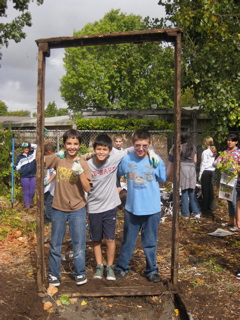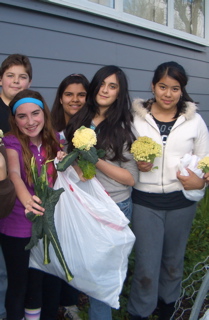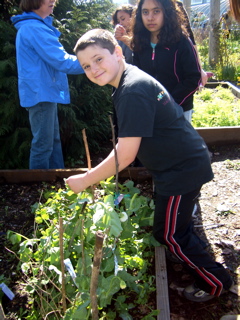
It was back in September, when I received an email from Nicole Calmels, a sixth grade science teacher at Hill Middle School in Northern California, asking for parent volunteers. The school's garden had been neglected for the last 3 years and she wanted to resurrect it with her class. I told her I'd come by once or twice to lend some of my master-gardening advice, but I wasn't going to be conned into a long-term parent-volunteer commitment. I'd been around the block. "I'm from New York. I can smell a rope-a-dope operation two zip codes away," I told her.
Sigh ... I've been helping out weekly at the school garden now for the last 5 months. How can you leave when sixth-grader, Emily Weston says, "My experiences in the school garden have been some of the greatest times of my life." You can't leave. You're stuck. Sucker-punched by a sixth-grader.
I had no choice. I had to stay, so I decided to make it my goal to turn those kids into tree-huggers and flower enthusiasts for life, just like the junk food and video game companies aim to do. Imagine children addicted to something good that won't kill brain cells, clog arteries or make them sick, obese and clueless? But what is necessary for this cradle-to-grave gardening indoctrination is a passionate teacher and a visionary school principal.
"I couldn't bare to see the garden neglected any longer. I thought it would be a great opportunity for me to share what made me so interested in science in the first place; the outdoors," said Nicole Calmels. "Luckily our school Principal, Chona Killeen, was very supportive of the garden. The administration's support can rally teachers to work together on such projects, while lack of support can crush the desire to go the extra mile."
Thanks to Sonoma Compost, Dugdale's Landscaping and a group of determined parents and students, a Sunday afternoon in November was spent building 6 raised beds and filling them with soil and compost. After that, a small group of Master Gardeners, organized by Robi Aragon of Sloat Garden Center, came to help out once or twice a month. As student, Julianna Jochumson so eloquently put it, "The thing I like most about the garden is being able to have hands-on projects instead of sitting in a big, boring classroom all day." The Master Gardeners supervised groups of 4-6 students in various gardening tasks such as pruning roses, creating a compost pile and a worm bin, weeding, watering, dividing perennials and planting flowers that attract beneficial insects. Key science concepts like plant anatomy, food webs, decomposition, pollination and soil organisms were also discussed. Rows of flourishing broccoli, cauliflower, peas and kale, which were organically grown throughout the winter, were harvested just last week and a meal was served in the classroom. "I liked watching our school garden go from awful to amazing!" said sixth-grader, Jenna Hollander.
At the beginning of the year Miss Nicole, as her students fondly call her, asked the students to fill out a survey about their views on science. Over half the class said science was their least favorite subject. After a few months of the outdoor classroom, many of those same students now say it's their favorite subject. "I learned about photosynthesis and how growing an organic garden helps the environment," said student, Sammy Maher. "When we get to go out to the garden, it's always the best part of my day." Calmels says the garden has opened up so many opportunities for class discussion about home gardens, organic products, healthy foods, waste management and sustainability. She witnesses the students relating their lives outside of school to the school garden, instead of her trying to draw connections between the textbook content and the rest of the world. "I learned that I work better when I am doing or seeing what is trying to be taught to me rather then reading it out of a book," said classmate, Francesco De Pablo.
In the late fall, a class trip to Star Route Farms in Marin County was made possible by Marin Organic and Miguel Villarreal, Director of Food and Nutritional Services for the Novato Unified School District. The class gleaned heads of lettuce, which would have been tossed out, but instead were harvested by the students and donated to the local food bank. "When we got to go visit the farm we all got to hang out together and learn about nature at the same time, " said science student, Josue Diaz. "We all just got to be ourselves. It was like having a perfect day." This visit to an organic farm not only showed the class how food for many can be grown without harsh chemicals and the various weather challenges farmers who grow our food have to endure, but where real, healthy food that's not packaged, processed, laden with salt, corn syrup and so-called natural flavors comes from. It comes from the SOIL. Not from a box? Say what!

The Centers for Disease Control states "the academic success of America's youth is strongly linked with their health." Children who eat well are more likely to perform well and have fewer behavior problems. This outdoor learning, away from sitting at a desk (pretending to look interested), encourages students to explore and problem-solve, while also building their self-esteem, nourishing their bodies and spirit, and offering them an appreciation for the gifts of the natural world.
According to Dr. Michelle Ratcliffe, farm-to-school program manager for the Oregon State Department of Agriculture, "School Gardens are not a fringe element anymore. I must have received 1,000 calls this past year from people asking me to help them start a school garden or farm-to-school program." There are now roughly 4000 school gardens in California alone.

"There are other things that are even more important than the academic value of the garden; its effect on our children. In a world full of TV's, video games, online chat rooms and cell phones, the garden has instilled the intrinsic value of caring for our Earth and each other," says Nicole Calmels. "The friendships and camaraderie built from the hours turning the compost pile, taking soil samples, witnessing heads of broccoli grow from tiny seedlings, and learning botanical names cannot be measured. The feeling of self-worth from contributing to such a project as part of a team cannot be tested. Our garden has raised a 'science family' in the classroom. As a teacher, I couldn't ask for anything better than that."
For tips on incorporating outdoor classrooms into the science curriculum, visit the California School Garden Network. A guide to garden-based education using existing curricula in grades 2nd through 6th is available at www.csgn.org. The National Gardening Association also has a plethora of information on how to incorporate gardening into the school curriculum. Visit: www.kidsgardening.org.
For more pep talks on organic gardening, visit www.dirtdiva.com (where critics will be composted.)
Because I said so!
